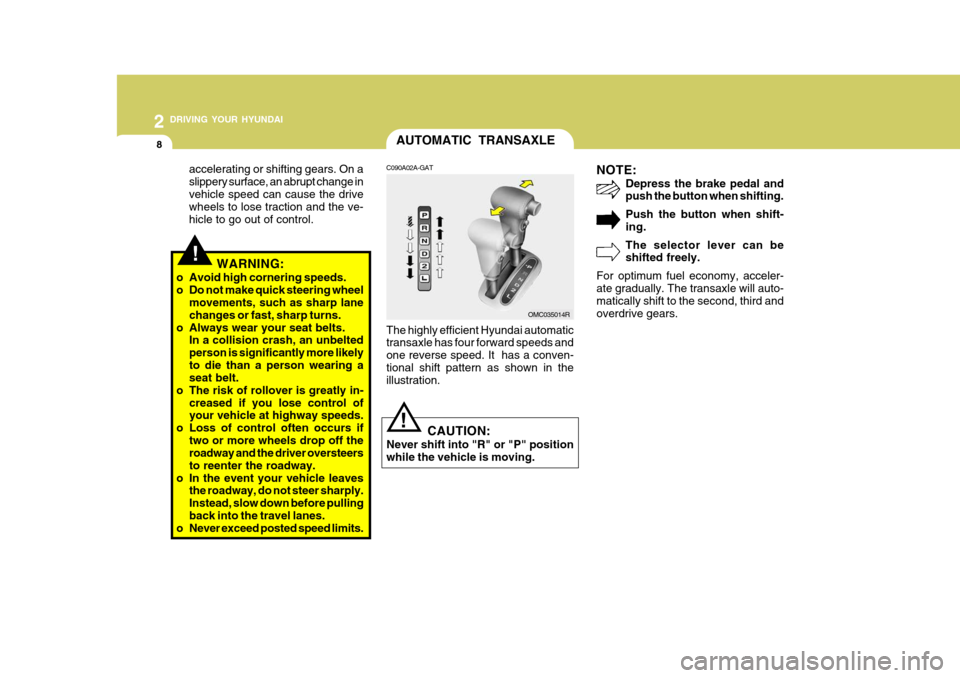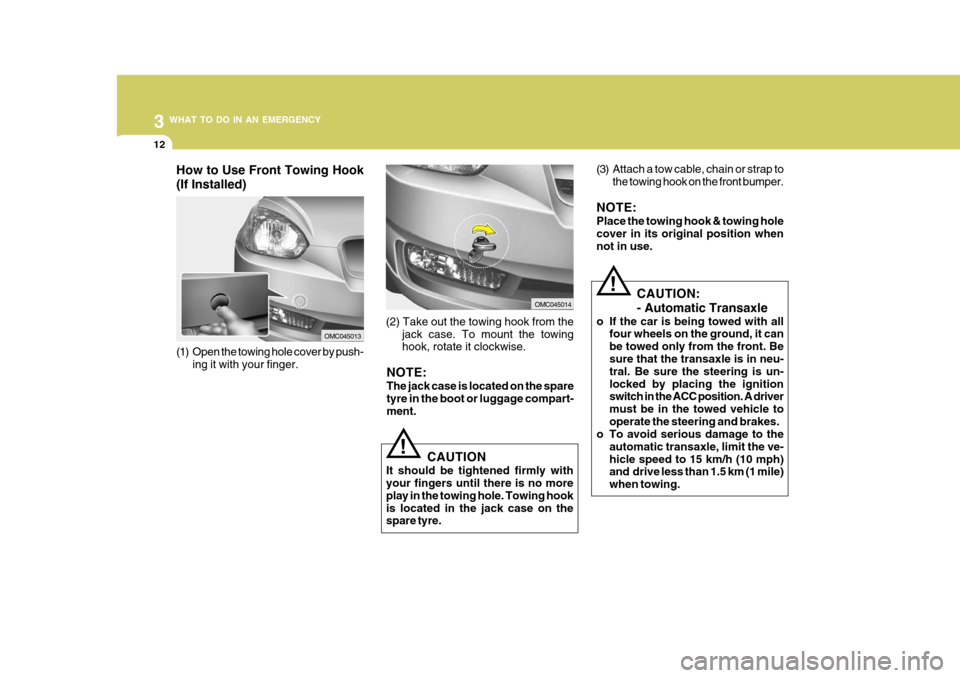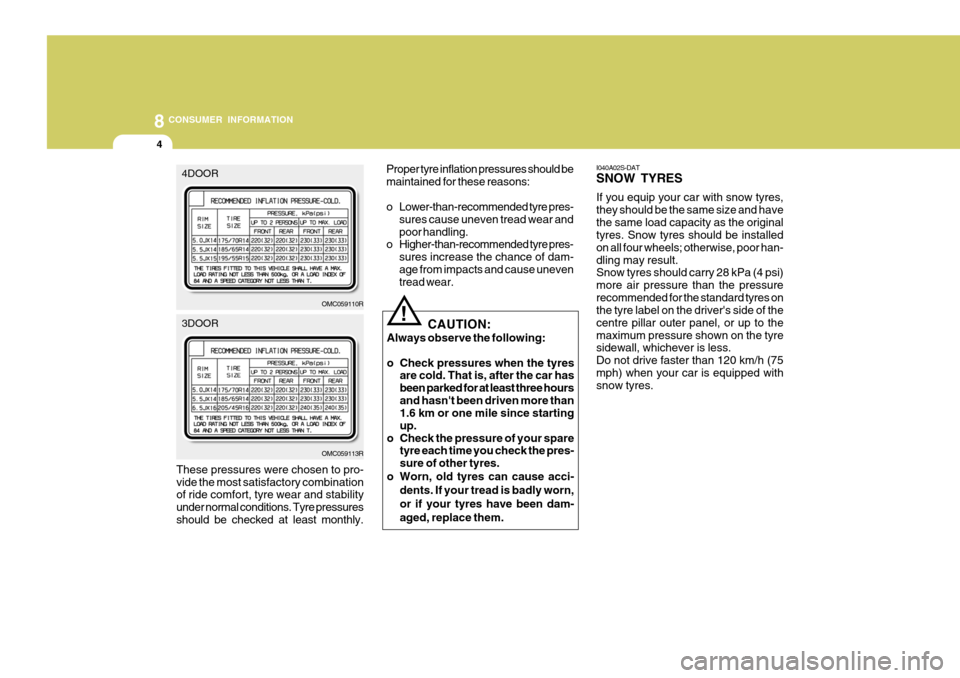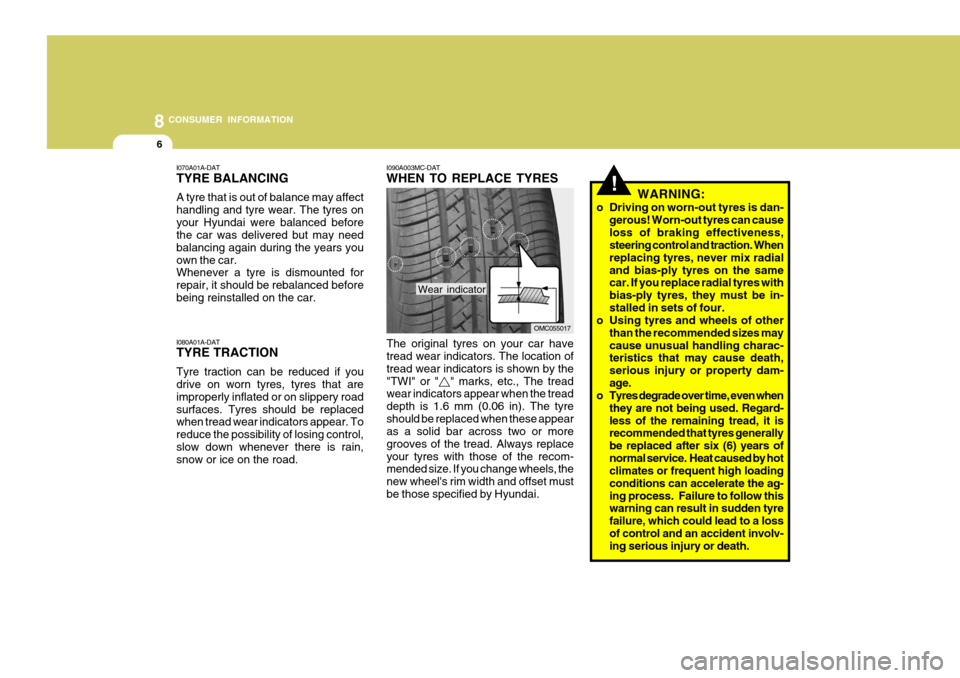Page 135 of 232

2 DRIVING YOUR HYUNDAI
8
!
AUTOMATIC TRANSAXLE
NOTE:Depress the brake pedal and push the button when shifting. Push the button when shift- ing. The selector lever can be shifted freely.
For optimum fuel economy, acceler-ate gradually. The transaxle will auto- matically shift to the second, third andoverdrive gears.
C090A02A-GAT
The highly efficient Hyundai automatic transaxle has four forward speeds and one reverse speed. It has a conven-tional shift pattern as shown in the illustration. CAUTION:
Never shift into "R" or "P" position while the vehicle is moving.
accelerating or shifting gears. On aslippery surface, an abrupt change invehicle speed can cause the drive wheels to lose traction and the ve- hicle to go out of control.
WARNING:
o Avoid high cornering speeds.
o Do not make quick steering wheel movements, such as sharp lanechanges or fast, sharp turns.
o Always wear your seat belts. In a collision crash, an unbeltedperson is significantly more likelyto die than a person wearing a seat belt.
o The risk of rollover is greatly in- creased if you lose control ofyour vehicle at highway speeds.
o Loss of control often occurs if two or more wheels drop off theroadway and the driver oversteers to reenter the roadway.
o In the event your vehicle leaves the roadway, do not steer sharply.Instead, slow down before pullingback into the travel lanes.
o Never exceed posted speed limits.
OMC035014R
!
Page 164 of 232

3 WHAT TO DO IN AN EMERGENCY
12
CAUTION
It should be tightened firmly with your fingers until there is no more play in the towing hole. Towing hookis located in the jack case on the spare tyre.
! (3) Attach a tow cable, chain or strap to
the towing hook on the front bumper.
NOTE: Place the towing hook & towing hole cover in its original position when not in use.
(2) Take out the towing hook from the jack case. To mount the towing hook, rotate it clockwise.
OMC045014
(1) Open the towing hole cover by push- ing it with your finger.
OMC045013
How to Use Front Towing Hook (If Installed)
NOTE: The jack case is located on the spare tyre in the boot or luggage compart- ment.
!CAUTION: - Automatic Transaxle
o If the car is being towed with all four wheels on the ground, it can be towed only from the front. Be sure that the transaxle is in neu- tral. Be sure the steering is un-locked by placing the ignition switch in the ACC position. A driver must be in the towed vehicle tooperate the steering and brakes.
o To avoid serious damage to the
automatic transaxle, limit the ve-hicle speed to 15 km/h (10 mph) and drive less than 1.5 km (1 mile) when towing.
Page 220 of 232

8CONSUMER INFORMATION
4
These pressures were chosen to pro- vide the most satisfactory combination of ride comfort, tyre wear and stability under normal conditions. Tyre pressuresshould be checked at least monthly. CAUTION:
Always observe the following:
o Check pressures when the tyres are cold. That is, after the car has been parked for at least three hoursand hasn't been driven more than 1.6 km or one mile since starting up.
o Check the pressure of your spare tyre each time you check the pres-sure of other tyres.
o Worn, old tyres can cause acci-
dents. If your tread is badly worn, or if your tyres have been dam-aged, replace them.
! I040A02S-DAT SNOW TYRES If you equip your car with snow tyres, they should be the same size and havethe same load capacity as the original tyres. Snow tyres should be installed on all four wheels; otherwise, poor han-dling may result. Snow tyres should carry 28 kPa (4 psi) more air pressure than the pressurerecommended for the standard tyres on the tyre label on the driver's side of the centre pillar outer panel, or up to themaximum pressure shown on the tyre sidewall, whichever is less. Do not drive faster than 120 km/h (75mph) when your car is equipped with snow tyres.
OMC059110R
OMC059113RProper tyre inflation pressures should be maintained for these reasons:
o Lower-than-recommended tyre pres-
sures cause uneven tread wear and poor handling.
o Higher-than-recommended tyre pres-
sures increase the chance of dam-age from impacts and cause uneven tread wear.
4DOOR 3DOOR
Page 222 of 232

8CONSUMER INFORMATION
6
!
I090A003MC-DAT WHEN TO REPLACE TYRES
The original tyres on your car have tread wear indicators. The location of tread wear indicators is shown by the"TWI" or "
" marks, etc., The tread
wear indicators appear when the tread depth is 1.6 mm (0.06 in). The tyreshould be replaced when these appear as a solid bar across two or more grooves of the tread. Always replaceyour tyres with those of the recom- mended size. If you change wheels, the new wheel's rim width and offset mustbe those specified by Hyundai. WARNING:
o Driving on worn-out tyres is dan- gerous! Worn-out tyres can causeloss of braking effectiveness, steering control and traction. When replacing tyres, never mix radialand bias-ply tyres on the same car. If you replace radial tyres with bias-ply tyres, they must be in-stalled in sets of four.
o Using tyres and wheels of other
than the recommended sizes maycause unusual handling charac- teristics that may cause death, serious injury or property dam-age.
o Tyres degrade over time, even when
they are not being used. Regard-less of the remaining tread, it is recommended that tyres generally be replaced after six (6) years ofnormal service. Heat caused by hot climates or frequent high loading conditions can accelerate the ag-ing process. Failure to follow this warning can result in sudden tyre failure, which could lead to a lossof control and an accident involv- ing serious injury or death.
OMC055017
Wear indicator
I070A01A-DAT TYRE BALANCING A tyre that is out of balance may affect handling and tyre wear. The tyres onyour Hyundai were balanced before the car was delivered but may need balancing again during the years youown the car. Whenever a tyre is dismounted for repair, it should be rebalanced beforebeing reinstalled on the car. I080A01A-DAT TYRE TRACTION Tyre traction can be reduced if you drive on worn tyres, tyres that are improperly inflated or on slippery roadsurfaces. Tyres should be replaced when tread wear indicators appear. To reduce the possibility of losing control,slow down whenever there is rain, snow or ice on the road.